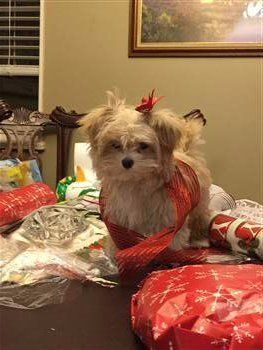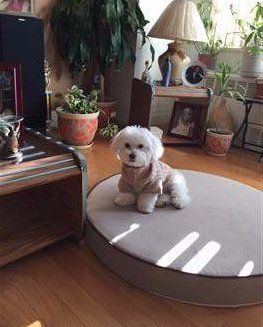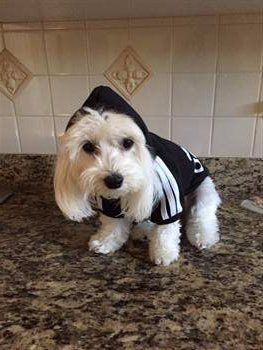When a Maltipoo Won't Eat
Overview
It’s an ongoing joke that dogs will gobble down anything and that they have bottomless stomachs which cause them to never stop eating, however those are just sayings and often apply to large breed dogs. With the Maltipoo being a toy sized dog, it certainly is not a joke if just the opposite happens and he won’t eat his food.
It can be frustrating and worrisome for owners who feel that they must constantly supervise their puppy or dog during dinner and put effort into making a dog eat. After all, shouldn’t eating be natural? When a Maltipoo is being finicky about food, is it something that will pass or will it be a lifelong issue? Is there anything an owner can do to make a Maltipoo eat more? is picky eating indicative of a health issue? These are all valid questions that we will answer here.
Please note:
PetMaltipoo is reader-supported. Some of the product suggestions on this page are affiliate links. As an Amazon Associate we earn from qualifying purchases. This is at no extra cost to you and helps us continue creating useful content.
The Canine Stomach VS a Human Stomach
Before we dive into why a Maltipoo won’t eat or doesn’t seem to eat enough, it’s important to know the differences in our anatomy. It’s interesting to note that when empty, a canine’s stomach folds up to be small; imagine an accordion, if you will. When a dog eats, it unfolds (expands) as food is consumed. If a dog were to keep eating, the stomach would continue to unfold until it reached its maximum size, holding approximately 7.5% of the dog’s body weight.
Let’s take a look at what that means… If you take a 10 lb. Maltipoo that eats until his stomach is full, he can eat .75 lbs. of food (3/4 of a pound). For a 5 lb. Maltipoo, the maximum amount of food that he can ingest at one time is only .37 of a pound.
The takeaway here, is that a Maltipoo’s ability to eat is based on his size and with this breed, it is not a large amount of food that other dogs can handle.

Abby, at 14 weeks old
Photo courtesy of Don Campbell
Calorie Needs
This plays a big role as well in why some Maltipoos do not eat with a robust appetite, since many dogs self-regulate; they will not eat more than their body needs. While us humans are used to eating anywhere between 1800 and 2500 calories per day to maintain, our dogs need much fewer. While such elements as age, activity level, health status and even environment temperature can affect the numbers by 20% less or more, in general a puppy only needs 50 calories per each pound of body weight and an adult Maltipoo only needs 40. Senior dogs with slowing metabolisms may eat less, generally around 35 calories per pound.
Let’s take a look at what this means for your Maltipoo. If you have a 5 lb. Maltipoo puppy, he will only need approximately 250 calories per day. If you have an 11-pound adult, he will need more, 440 calories per day, yet this is still a small amount when you compare it to what humans typically ingest. That same 11-pound senior Maltipoo may eat less, perhaps only needing 385.
How Many Cups of Food a Maltipoo Needs
Just about every owner wants to know exactly how much their Maltipoo should be eating, to make sure that they are receiving enough food. Yet, if you are looking for the answer to be given in quantity (i.e. ounces or cups), that answer can vary wildly. If you take inexpensive kibble (that contains worthless fillers), a high quality dog food, homemade food, manufactured meals, wet and dry options, the amounts per serving will vary from 1/4 to 3/4 cup.
The Takeaway
If you are worried that your Maltipoo is not eating enough, do realize that being in the range of 5-12 lbs. (2.27-5.44 kg), a Maltipoo may not need as much food as you might think. While it is extremely important to make sure that your puppy or dog is being fed the best food possible and to make sure that your Maltipoo is in excellent health, if your puppy is growing as he should or if your adult is maintaining, this means that he is indeed eating enough. This said, there are steps you can take to ensure a bit more enthusiasm during meals, which we will discuss ahead.
6 Top Reasons Why a Maltipoo Will Not Eat
This section lists out the most common issue seen with picky or finicky eaters, meaning that the Maltipoo is growing or maintaining as he should and is not
having any health issues. If your puppy is not gaining, your adult is losing or your Maltipoo of any age is having signs of a health problem, you will want to look to the next sections. It should also be noted that baring any health issues, if you can’t find a food that your Maltipoo likes, most of these will apply as well.
#1. Waiting for something better.
Time and time again, we hear from owners with these same basic questions, “I want my Maltipoo to eat his meals, but he refuses. He’ll only eat certain snacks that he loves, what can I do?” or “My Maltipoo won’t eat from his bowl and flat-out refuses his food, he’s now only eating my leftovers, any ideas?”
In these cases, the dog has learned exactly
how to receive the food that he prefers… all he must do is play a game where he does not eat what’s given. He waits. His owner then offers him what he wanted all along, those table scraps or those treats that were supposed to just be for reward.
What to do: If you know that you are offering a 4 or 5 star, high quality dog food and that your Maltipoo tolerates it well (no upset stomach or other issues), this is a matter of standing your ground. And for dogs that are a bit spoiled, there will be an adjustment period. However, you should place the food down and not offer secondary options. When a dog is hungry enough and realizes that nothing else is going to be offered, he will eventually eat his food. He may do this halfheartedly at first, however as time goes on, it will become the new ‘normal’.
#2. Servings are too large. If you set down 1/2 cup, 3 times per day, but your Maltipoo is only eating half of that amount (and he a puppy that is growing properly or an adult that is keeping his weight steady), your best bet is to offer 1/4 cup, 3 times per day. In other words, only feed him what he will actually eat.

Rocky, at 10 and 1/2 months old
Photo courtesy of Yvonne Bentley
This way, you will not worry that your dog is not eating, food won’t go to waste and your dog will do what he’s been doing all along, receiving the amount that he needs. Do, however, keep in mind that with puppies, that amount will increase every month or so. As he gains weight, he will need more to maintain. Each pound gained equals about another 50 calories per day.
#3 Unconducive eating environment.
There are several elements that can throw a dog off, causing him to not eat as he normally would. If there is lots of commotion or activity in the house, he may become too excited to focus on his food. If there is lots of foot traffic or people sitting too close to his eating area, a Maltipoo may not feel safe eating; canines need to feel that their food is safe and eat best when there are no interruptions. The addition of another pet can cause a temporary eating issue if the pets’ bowls are placed too close together. You will want to reassess your Maltipoo’s dining area to make sure that he has his own space where he is not bothered by noise, people or other animals.

Nora, at 11 months old
Photo courtesy of Stefanie
#4 Incorrect bowls.
This is most applicable to Maltipoo puppies that are not eating enough. While it is very important to rule out health issues (more ahead), something as simple as the depth and size of the bowl can be to blame. Deep or large bowls can be difficult for small puppies to eat from and the easy fix to this is to obtain a small shallow puppy-sized stainless steel bowl. There will be the occasional Maltipoo that for whatever reason is very picky about the height of his eating surface, either preferring a flat plate or a raised bowl.
#5 Meal timing.
While it’s always a good idea to have a feeding schedule, the meal times that you choose may not be best for your Maltipoo, causing him to not eat as much as he would otherwise. It is common for owners to want to feed their dogs as soon as they get home from work, since it’s normal to assume that a Maltipoo left home all day will be more than ready to eat.
However, many dogs want to have other needs met first and if they are not, the dog will not eat or will barely pick at his food. Of course, bathroom needs are a top element, however in many cases, a Maltipoo will also need some play time, exercise and some attention before he can transition from ‘home alone’ to ‘my owner is back home’, relaxing enough to then eat his food.
#6 Treats are given too frequently.
Who doesn’t love to offer a special treat to their dog? It’s natural to want to ‘mother’ our pets and giving treats is part of that, however if too many are doled out, this can ruin a dog’s appetite and he will then have little enthusiasm to eat a full meal. And it’s important to note that the main caregiver of the dog may not realize that others in the household are handing out snacks all day.
You’ll want to get everyone on board that treats are only to be given as reward for specific actions (such as going potty in the designated area or listening to a certain command) and for those Maltipoo that only eat treats but refuse meals, those treats can be cut in half or in thirds, so that the dog does not fill up on them.
Not Eating to the Point of Causing Issues
While the previous advice will apply to the typical fussy eater, if your Maltipoo puppy is not gaining weight or if your adult is losing weight, this points to a much more serious issue. A dog refusing food goes against his canine instincts to survive, so this must not be ignored.
In addition, there is always the chance that a short-lived stomach bug or other intestinal distress is causing a temporary lack of appetite, however if a puppy does not eat for 24 hours or an adult Maltipoo does not eat for 48 hours, it is a clear sign that the dog needs to be taken to the veterinarian.
Red Flags and Health Conditions
There are host of health issues that will cause decreased appetite in canines, in fact if you look at just about any condition, illness or disease, it is among the signs and symptoms. Parasites are always a concern, though issues ranging from dental infection to kidney disease can be to blame.
The most common issues seen alongside refusal to eat include vomiting, diarrhea and/or lethargy.
Acute cases of mild to moderate upset stomach can often be treated at home by withholding food for 12 hours and then transitioning to a bland diet. Pumpkin (the real type, not the pie filling) can sometimes calm down both diarrhea and intestinal upset. And you may want to speak to your vet about offering Pepto Bismol, as this can help in some cases.
If things do not improve within 24 hours for a puppy or 48 hours for an adult dog or if symptoms become worse, you will want to bring your Maltipoo to the vet clinic, as dehydration is a top concern and of course, diagnosis of the root cause must be determined.
Adding Incentive to Eat
While you do not want to spoil your dog with table scraps or give in to any stubbornness if a Maltipoo is holding out for treats instead of his food, in some cases making a change to his meals is warranted to encourage the dog to eat.
Following the guidelines previously listed in regard to offering a quiet eating area, timing the meals right and making sure that your Maltipoo is comfortable with his bowl will help, and here are some additional tips to help a Maltipoo eat more:
1) Warm up the food.
Older, senior dogs often do best with warmed food, though a Maltipoo of any age may be more receptive to his meals if they are warm (not hot).
2) Add moisture.
Together with warming the food or as a standalone option, often adding some liquid to kibble can be just the thing to prompt a dog to eat more. Low-sodium chicken or beef broth is a good method to do this, though do be sure to mix it throughout the food as adding it just to the top may result in only the top portion being eaten.
3) Fish oil.
Without overdoing it (too much can cause diarrhea), Omega 3 (fish oil) is great for dogs; it is beneficial for both skin and coat health, can help dogs with joint problems and can even boost a dog’s immune system. You may want to speak to your vet about adding fish oil to your Malitpoo’s meals, which most dogs find to be delicious. Dosing size will depend on which brand you use, so do be sure to read the label.

Lexi, at 1 and 1/2 years old
Photo courtesy of Myra Alicea
4) Double check the freshness
- Kibble can get stale surprisingly quickly and this can cause a dog to stop wanting to eat a food that he previously loved. Rolling up a bag does little to stop this from happening, yet it is what owners most often do. To keep food fresh, and therefore tasting its best, you may opt to buy smaller bags or use a quality dog food storage container to lock out air, allowing food to retain moisture and flavor, tasting as it was meant to.
Things to do now:
Become a free Member
(if you are not already a Member) so that you'll receive a friendly reminder we add new pages of information to this site. You can also suggest a topic for us to write about or ask a question about your Maltipoo.
See all top recommended care items on the Maltipoo Supplies
page; this covers everything from 'stay busy' toys to shampoos... and separation anxiety aids to beds that give proper support.


